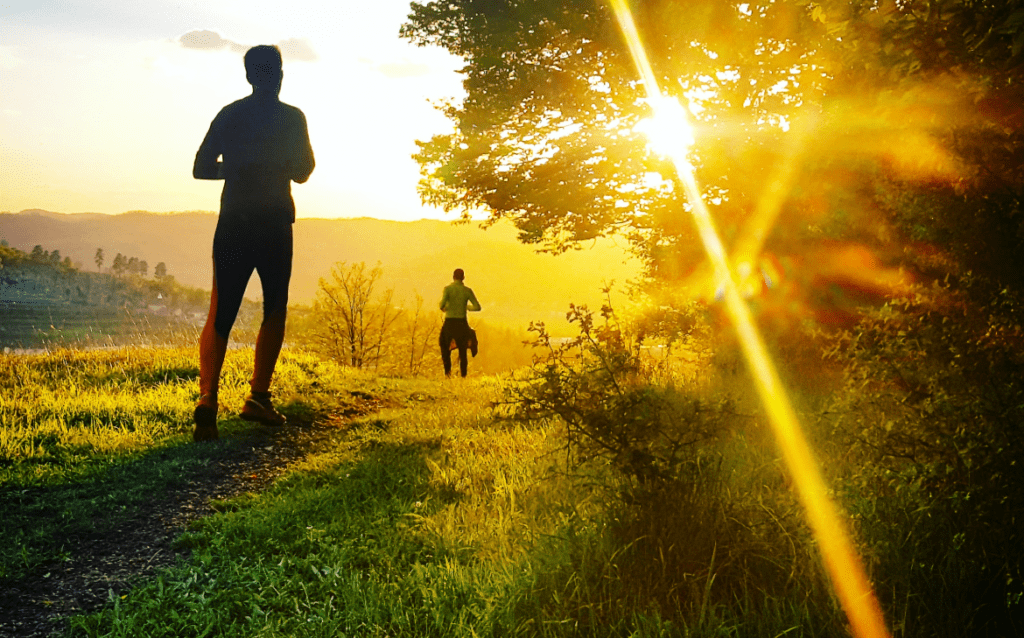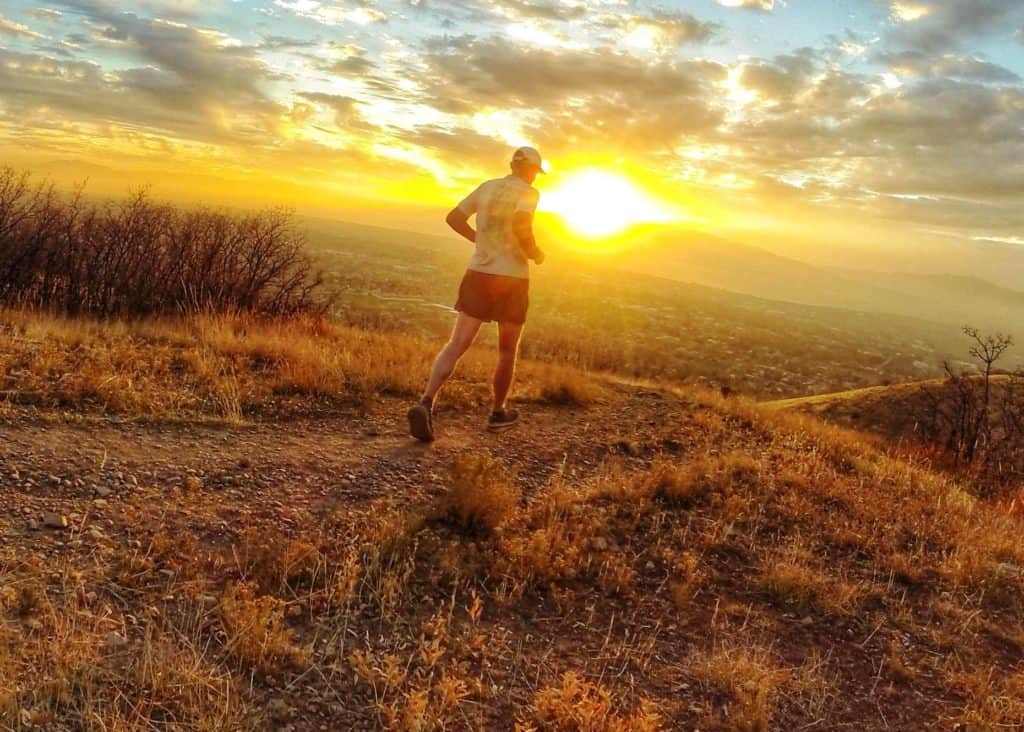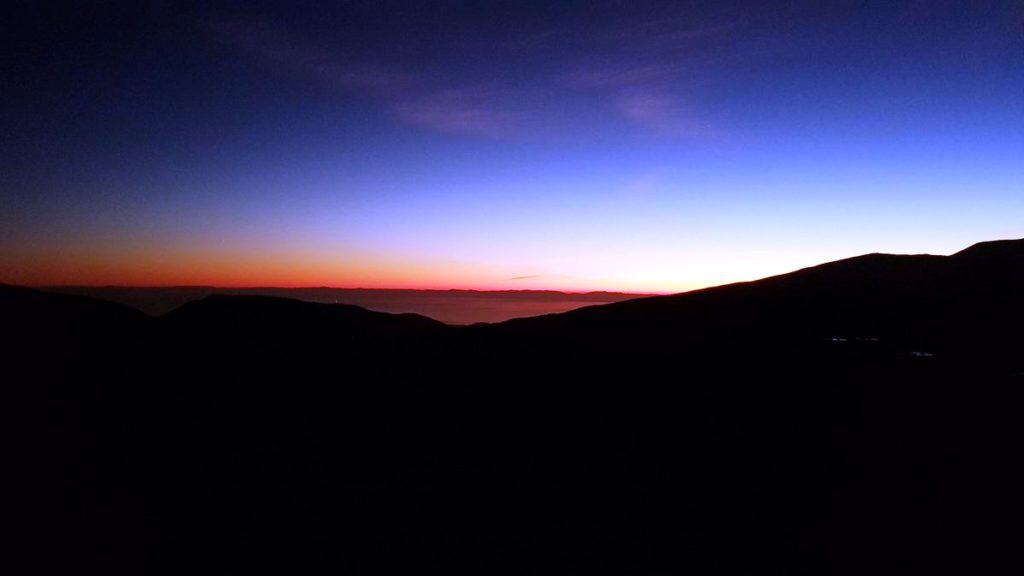
Back when I had a mountain bike I used to enjoy that silence that came from riding at night. That got me wondering about how to start trail running at night.
How to trail run at dusk?
- Wear bright clothing to be visible to other trail users.
- Have a strong enough head torch to see where you are going.
- Carry a mobile phone to call for help if something goes wrong.
- Carry a whistle – the sound of a whistle carries further than a voice in emergencies.
- Plan your route and tell someone where you will be, with ETA and panic time.
- Do not deviate from your planned route if at all possible.
- GPS track your run so that you can find your way back in the dark.
- Pre-run new trails in daylight.
- Run with a friend/partner.
Running at dusk into the night requires more planning and preparation than daytime running. However, by adding a couple of safety elements you will be able to enjoy one of the most beautiful times of day to get out on the trails.
The Essential Dusk Trail Running Tick List
There are two important aspects to remember when you make the switch from daylight to dusk out on the trails. The first is visibility and the second is safety. Because there are far fewer runners out on the trails after dark you will need to be a lot more self-sufficient, and pack accordingly.
Write down the bullet list above and pin it up where you keep your trail running gear.
Wear Bright Clothing
The reason for wearing bright clothing to be highly visible is obvious when you are running on a paved road at dusk or after dark. On paved roads you are sharing the space with cars. I know, you don’t encounter cars out on the single track trails.
What is possible is that your route may merge with a forest road that could have a car or two, especially at around dusk. Young lovers often take a dusk drive up a forest road to a romantic lookout, or simply to find some privacy.
Another possibility is that your trail could have one or multiple paved road crossings.
And finally, there is a very good chance that you will encounter other runners and also mountain bikers enjoying one of the most beautiful times of the day. Especially for mountain bikers, when going downhill, they need a hundred yards or more of visibility to react to anything in their path.

Have a Strong Enough Head Torch
Many hiking shops and websites talk about having a head torch of around 100 Lumens. Sure, that will be fine at dusk for the last mile or two to your overnight stop or for cooking dinner in your tent.
I tried trail running with a 100 Lumen head torch in the past and have the scars on my knees to show for it.
In order to prevent tripping over things I need to be able to see from immediately in front of me out to between twenty and twenty five yards up the trail. For this reason anything under 300 Lumens simply doesn’t work for me as a head torch.
Back when I used to go mountain biking pre-dawn I used my 150 Lumen head torch. However, that was just to supplement the 450 lumen light that I had on the handlebars. What the head torch did for the mountain bike was eliminate shadows in the five yards immediately in front of me thanks to lights shining from two different angles.
I haven’t tried it yet, but I’m sure that having a second waist strap mounted light will have the same benefit of eliminating nearby shadows and reduce the chances of tripping.
If you start your run while it is still daylight you need to be aware that you have around thirty minutes of civil twilight after the last sliver of the sun has dipped below the horizon. Depending on cloud cover you will start needing your head torch fifteen to twenty minutes after sunset. Anything beyond that and you start to lose depth perception.
Don’t be fooled by a full moon either. I remember doing a full moon hike on a rocky single track that thigh high bushes on either side of the trail. The bright moonlight reflecting off the bushes was almost blinding while the rock strewn path was nothing more than an inky black line cutting through the brightness. It took me over an hour to inch my way down less than a mile of mountainside.
Carry a Mobile Phone
This seems really obvious. If something goes wrong out on your run you will need to be able to call for help.
A second reason to have your mobile phone is that most mobile phones have a built in torch. So if your extra strong head torch dies on you out on the trail, you will not be left completely stranded in the dark.
Another very useful use of a mobile phone is mobile tracking. Mobile tracking is useful for daytime trail runs as well, especially when you run solo as I often do. That allows someone to be able to track your movements using the phone’s GPS. So if something were to go wrong it will be easier for a rescue team to be deployed to your exact location quickly.

Carry a Whistle
This is something that I learned very early in my mountain training. Always have a whistle with you, day or night. The reason is super simple.
If you get into trouble, the shrill sound of a whistle carries much further than a shout. Also, when you continue shouting you will blow out your voice and lose your ability to shout for help. Finally, if you are stuck out in the wild for a long time, fatigue will weaken you to the point where you can hardly shout at all. You will still be able to blow a whistle loud enough to be heard miles away in the quiet mountains.
Plan Your Route and Tell Someone
Route planning is vital when running at dusk and into the darkness. Firstly any of your long distance navigation reference points will no longer be of any benefit. A planned route means the ability to anticipate where a specific corner or path change is in the dark.
This is something that I do when I go on a long, unsupported trail run during daylight hours. I write navigation notes on a card or series of cards. Friends have teased me about my navigation cards. However, cards don’t break a screen when you drop them, or when you trip and fall. Plus cards don’t have batteries that can go flat.
The follow up to have your route planned is to make sure that there is someone that knows your intended route. Again, if something goes wrong and you need help it is important for people to know where to look. I remember from my mountain rescue days receiving calls from a

Do Not Deviate from Your Planned Route
This is the logical follow up from the previous section. When at all possible, do not deviate from your planned route. Sure there will be times where short small deviations become necessary. I am not talking about those. I am talking about making a massive route deviation.
Retreating back the way you came along the same route because of an obstacle or becoming disoriented is also perfectly fine. You are essentially still on your original route, just in the opposite direction.
By way of example, I was recently on a solo run and I reached a point where the trail went along a rock ledge for about two miles, maybe less. I got to a point where a massive rock fall had obliterated the trail completely. I could see where the trail continued a hundred yards away but there was no safe way across the loose scree.
So I doubled back along the until I reached a point where I could safely scramble down to a lower ledge. That lower ledge was intact across where the rock fall had happened and actually merged with the original trail a quarter mile further. Although it was a deviation, it made the outing safer.
When I returned to the same trail a year later, my deviation had become the new trail.
GPS Track Your Run
These days GPS tracking your run hardly seems like a relevant piece of advice. Just about everyone is GPS tracking their run to upload to STRAVA or someplace similar.
However, there is another feature that your GPS unit likely has that you have never used. It is called Return To Start. Do yourself a favor and learn how it works. If you get completely lost in the dark along your dusk to darkness run, Return To Start will retrace your steps back to the trailhead.

Pre-run New Trails in Daylight
Even if you have route navigation cards and are GPS tracking your run, it is always a better idea to explore new trails during daylight hours.
Aside from better helping you to navigate the terrain, having some degree of familiarity of your surroundings will go a long way to increase your confidence during the twilight hours. This is especially so while you are still new to trail running at dusk.
Run With a Friend/Partner
Whenever you head out onto the trails, there is always safety in numbers. Should someone have a bad fall, there will be someone that can go or call for help.
If you are new to dusk and night running as around at gear shops to hear if there is a local group that organizes dusk and night runs. Ultra-trail events invariably will have at least part of their route run at dusk, night or dawn. As a result, there will be ultradistance runners training for those conditions.

Related Questions
How to trail run at night? When you trail run at night you need to make sure that you have bright or reflective clothing so that you can be seen by other trail users from a distance. You also need to ensure that you have a head torch of at least 300 Lumens to properly light your way.
How to trail run at dawn? If you start your trail run at dawn you can get away with a head torch of around 100 Lumens for the first 20 minutes of your run. After that, there will be sufficient daylight to see where you are going. However, it is always a good idea to wear bright highly visible clothing when trail running at dawn.
